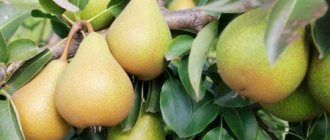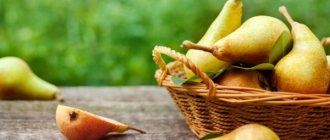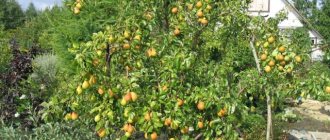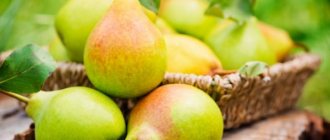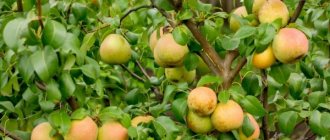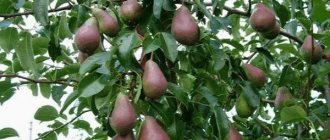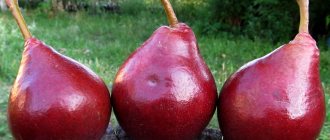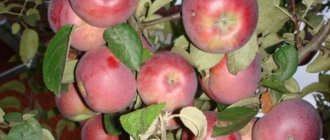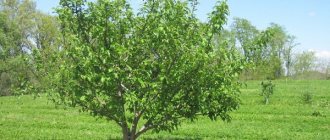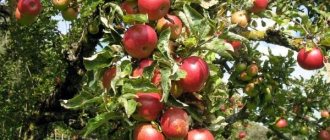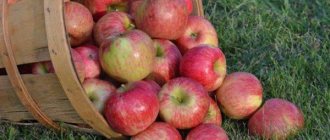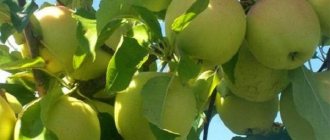Description of Favoritka pear variety
The variety is popular among modern gardeners. The American breeder T. Clapp, who developed the variety in 1860, is considered its creator. This pear is also commonly called Clapp's Favorite. Thanks to its excellent varietal characteristics, the pear was able to win the universal respect of gardeners and consumers.
Did you know? European residents smoked pear leaves until the end of the 15th century, until H. Columbus brought tobacco to the continent from America he discovered.
Description of the tree
In accordance with the botanical description, Favorite is classified as a fast-growing tree. An adult plant reaches a height of 5-6 m. As the young tree grows, a small, sparse and weeping crown of a pyramidal shape is formed. The trunk of an adult tree is powerful. The bark on the branches is smooth, but on the trunk it is slightly flaky. The leaves have an oval shape with a pointed end. The flowers are large, white, and form an inflorescence of 6-7 pieces. The fruiting period of an adult orchard is 50–60 years.
Description of fruits
The size of the fruit varies between medium and large. The maximum weight is 252 g, and the average is 180 g. The shape of the fruit is elongated, ovoid with delicate and smooth skin. The pear pulp is tender, juicy, white in color with a pleasant sweet and sour taste. Ripe fruits are yellow with a bright red spot on the illuminated side. Small, barely noticeable dots are visible on the peel.
Find out what a pear is and what its features are.
Ripe pears contain many nutrients, namely:
- dry - 13.7%,
- titratable acids - 0.4%,
- sugar - 8.3%,
- ascorbic acid - 6.6 mg per 100 g.
Pests and diseases
The Favoritka variety is resistant to pear diseases, but if all sanitary and preventive measures are taken, many problems can be completely eliminated.
Rust on the pear
Preventive measures:
- In the fall, leaves, weeds and other debris are collected and burned in order to destroy the pests in them.
- The bark needs to be checked. If cracks or other damage are noticed, the wood needs to be treated. Clean the affected areas to undamaged tissues and disinfect with copper sulfate 1%. Garden varnish is applied to this place. The procedure will protect against gommosis and black cancer.
- The trunk and thick branches are whitened with a solution of slaked lime mixed with copper sulfate and PVA glue. This prevents the bark from cracking and pests from moving onto the tree.
- The earth is dug up around the trunk. The insects located there will die in frost. They are also sprayed with 3% copper sulfate or Bordeaux mixture to prevent fungal diseases and pest invasions. In early spring the procedure is repeated.
- In March, they are treated with strong drugs DNOC or Nitrafen. They kill all pests.
- In early spring, trapping belts are installed. These are self-made traps from roofing felt, fabric, film. Such devices help against many types of insects such as weevils, ants, caterpillars.
Whitewashing pears
- Before the pear blooms, it is sprayed with insecticides against insects: Decis, Fufanon, etc. Treatment is also done after flowering.
- After the buds wither, they are sprayed with fungicides: Horus, Quadris. In order to prevent the formation of fungi after flowering. It needs to be processed regularly, once every three weeks.
Actions for illnesses:
- Moniliosis. This is a fungus that causes leaves and flowers to turn black and wither. The shoots look like after a burn. Affected branches need to be pruned, including some healthy wood. Treat with Horus at an air temperature of no higher than 22 degrees. Repeat after 10 days. The same product cannot be used more than three times due to the fungus becoming accustomed to fungicides. If the disease continues, fruit damage may occur. They cannot be consumed because they become rotten. Then the tree is treated with Strobi. The drug is strong, so pears can be eaten after 20 days.
- Sooty fungus. Develops with the appearance of aphids or copperheads. They produce honeydew, which helps the fungus spread. Leaves and fruits are covered with a soot-like coating.
Fungus on a pear
Actions in case of pest attack:
- Aphid. It is brought in by ants because they feed on honeydew. Catching belts are used for fighting. When these insects live, the leaves curl. The leaves on the tree are torn off or the drug Decis is used, which destroys all insects.
- Pear copperhead. A small insect, otherwise called a psyllid. When it invades, the leaves fall and the fruits turn to stone. There are a large number of its varieties. In addition, sooty fungus appears. The Commander is used for treatment. It kills insects within a day.
It is better to carry out preventive treatments of trees in a timely manner to prevent severe infection by diseases and pests.
Aphids on a pear
Advantages and disadvantages of the variety
Like any fruit, the Favoritka pear has advantages and disadvantages, which you should familiarize yourself with before planting the plant.
- The advantages of Favorite include:
- resistance to severe frosts;
- excellent tolerance to dry summers;
- high productivity on infertile soils;
- high commercial quality of fruits;
- resistance to pests and diseases.
- According to professional gardeners, the variety has the following disadvantages:
- late period of tree fruiting (7–9 years of life);
- the future harvest depends on neighboring pollinators, the variety is not self-fertile;
- poor resistance to scab;
- high growth of an adult tree;
- short period of preservation of picked fruits, tendency to shedding.
Reviews from gardeners
Nuitoha (city of residence - Sumy)
Pear Favoritka is one of the best early ripening varieties of this group of fruit trees. Although he has been undeservedly forgotten in recent years. I myself grow this fruit tree in my garden, the taste of ripe fruits is quite excellent, as well as the unpretentiousness of this pear.
Natalya S. (Krasnodar region)
Favorite is the best summer pear on my site with excellent yield. I would like to note one minus of the tree - I had to wait quite a long time until this variety began to bear fruit.
Victor I.S. (Kharkiv)
Favorite pear is truly loved by children and their parents for its juicy and sweet fruits, delicious aromatic preserves and jams that are made from the harvested crop.
In short, this variety will appeal to lovers of sweet fruits, and novice gardeners will enjoy the ease of care for this fast-growing and well-fruiting pear tree. And if you apply fertilizing in a timely manner and improve the composition of the soil in the tree trunks, the yield will increase several times.
Agricultural cultivation technology and care
The fruit requires normal care, which includes standard agricultural techniques taking into account varietal characteristics.
Important! To protect the plant from the negative effects of pests and solar activity, it is recommended to whitewash the trunk with lime mortar. Also, for the winter, the tree trunk and main branches can be coated with a mass of clay and lime with the addition of substances with a strong odor.
Landing dates
It is advisable to plant the variety before bud break in the spring. At this time, the young seedling spends all its energy on rooting and growth. To carry out spring planting, preparatory work must be carried out in the fall.
Selecting a site and preparing holes
The gardener must choose a location responsibly, because the pear will have to grow there for decades. To plant a tree, you need to prepare a hole 1–1.2 m deep and 80 cm in diameter. The seedling should be placed carefully in the hole so that the roots are straightened. The root collar is placed 3 cm above ground level.
For better growth, the tree is grown in the south or southwest side of the garden. The landing site should be well ventilated and protected from winds. It is recommended to choose loose, well-drained and slightly acidic soil for planting seedlings, without stagnant water.
Important! It is advisable to place drainage at the bottom of the hole, and add compost or humus mixed with soil on top. It is enough to add 3-4 kg to one hole.
Watering frequency
After planting, young seedlings should be watered abundantly. It is recommended to add up to 3 buckets of water under each tree. Further care is important to obtain stable yields in the future.
In the first year of growth, the young garden is watered frequently, without allowing the soil to dry out; 3-4 waterings per season are sufficient. In the future, water 3 times a year, to the entire depth of the roots. The volume of watering should be such that water can penetrate to a depth of 75–85 cm.
Fertilizer application
If a sufficient amount of fertilizer is added to the hole during planting, there is no need to feed the young plant for 3-4 years. Peat, humus and sand should be added to the planting hole in equal quantities, 400–500 g of superphosphate and 2-3 liters of dissolved wood ash should be added.
Features of care
Comprehensive pear care Favoritka includes the following processes:
- watering - in the year of planting, the tree must be watered frequently, preventing the soil from drying out; subsequently 3 times a year - so that water penetrates the entire depth of the root system;
- It is enough to apply fertilizers 2 times per season: at the beginning of the growing season (nitrogen complex) and after harvesting; in September-October (potassium, phosphorus);
- regular loosening or mulching of the tree trunk area;
- crown trimmings – formative in the fall, sanitary in the spring.
Before fruiting begins, pears are very susceptible to cold and can freeze out, so in the winter the tree trunk needs to be covered with mulch, and the tree itself should be covered with snow. Mature trees can survive winter without shelter.
Harvest and storage
Clapp's favorite is a summer variety, so the picked fruit has a short shelf life. Harvest occurs at the beginning of August. If it is necessary to preserve the harvest for a long time, it is recommended to pick the fruits unripe, along with the stalk. However, for ripening the fruits must be dry and kept in a room that is regularly ventilated. It is better to harvest in the first half of the day.
Video: when to harvest pears
It is recommended to store fruits in clean containers. When stored indoors, pears will last about a week. You can store the pear in a plastic bag with a thickness of 30–60 microns and a capacity of up to 2-3 kg. To do this, the fruit should be pre-cooled and sealed tightly after packaging. You can also store fruits without using containers, laying them out on paper-lined racks. To immediately see which fruits are starting to rot, it is recommended to place them in one layer. This will promptly prevent infection of neighboring fruits.
We advise you to learn about the features of storing pears for the winter at home.
Having studied the description and main characteristics of the Favoritka variety, as well as adhering to the above rules and recommendations for caring for it, you will certainly get a good harvest of pears.
Favorite Red
There is also a Red Favorite pear. In terms of its characteristics, it is very similar to Clapp's Favorite, which is why these varieties are often called sister varieties. Red's favorite was obtained by crossing Flemish and Boncreta Williams.
Pear "Red Favorite"
Appearance and characteristics of Favorite Red
The fruits of this variety differ from those described above, as you might guess, mainly in color. The smooth skin is completely red with a purple tint. You may also notice light spots visible through the peel. The weight of one fruit is 140-160 grams, but larger ones are also found.
The pulp is practically no different in appearance and texture from the Favoritka pulp, but has a more subtle aroma. The productivity is very high, the fruits can be harvested every year. They also, as in the previous case, tolerate transportation well and retain their presentation. However, according to reviews from gardeners, pears of this variety, if stored improperly, very quickly begin to rot from the inside.
Pear "Red Favorite"
The fruits are harvested in early August, when they are still yellow. They reach full maturity in the refrigerator in a month. The shelf life of pears in a cool, dry place is also one month.
The fruits are most often consumed fresh, but they are also suitable for making preserves, juices and jams.
Favorite Red is a medium-sized tree with a compact crown. It begins to bear fruit in the fourth year of planting. Its pollinators are the following varieties: Bere Bosk, Dessertnaya, Williams and Tavricheskaya.
Pear "Tavricheskaya"
Landing
Let's find out how to properly plant the Favorite pear on the plot, what nuances need to be observed.
Selecting a location
The best option for planting this pear is a plot (or slope) from the south or south-west. Take care to protect the tree from the north wind: the pear, despite its frost resistance, does not favor drafts.
It is also important that the area is well lit: abundant sun will help the fruits ripen faster and better.
The soil must meet the following parameters:
- be loose, drained;
- acidity to be neutral;
- no waterlogging.
You cannot plant a tree in lowlands: moisture stagnation there is guaranteed, and this is a very likely problem for the roots.
Deadlines
It is best to plant in the spring, choosing a period before the buds begin to bloom. By autumn, the seedling will already be strong enough to survive the cold winter safely.
Selection of seedlings
We advise you to purchase this variety in Ural nurseries - it is there that you are most likely to purchase a varietal plant and not run into a “fake”. But you can also make a purchase from a trusted seller in your region.
The seedling requirements are as follows:
- age one to two years;
- well-developed roots without signs of rot or damage;
- the bark is smooth, without defects or cracks.
If you bought a seedling in the fall, then store it in the basement/cellar until spring. Well, or you can dig it into the ground. Optimal temperature for preserving the plant: +2-5 degrees, do not allow freezing.
Pit preparation
They prepare a hole for planting in the fall. Standard pit parameters: 70x80 cm, one meter deep. Drainage from:
This layer should be 10-15 cm thick.
A layer of nutrient soil is placed on the drainage, consisting of:
All components must be taken in approximately equal proportions. Add to the resulting mixture:
- superphosphate (500 grams);
- ash (3 liters).
Mix everything thoroughly and put it in the hole. After this, cover the future seat with film and leave it like that until spring. Fertilizers will saturate the soil over the winter, making it nutritious and fertile.
Planting process
- Before the procedure, the seedling should be removed from its storage location and its roots should be soaked in a growth stimulator.
- Part of the soil is removed from the hole to make room for the plant.
- A peg for garter is driven into the center of the hole.
- The seedling is placed in a hole so that its root collar is flush with the soil surface.
- Fill the hole with soil, doing this carefully so that the roots of the plant are not damaged.
- After the plant is planted, it is tied to a stake. The material for the garter should be soft, elastic, but durable.
- The pear is watered with copious amounts of water, trying to achieve the complete disappearance of air pockets in the pit.
- After a day or two, the soil is loosened and mulched with sawdust, humus or hay.
- The central conductor is trimmed, leaving it at a height of 70-100 cm. The branches must be shortened to 20-30 cm.
